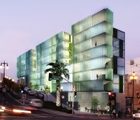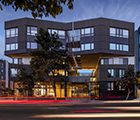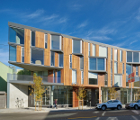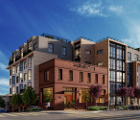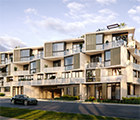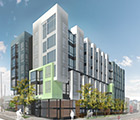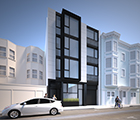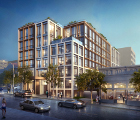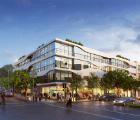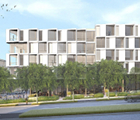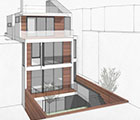PRESS
Read DM Development's latest news and press releases
Gas Stations Fuel Condo Boom as Developers Scoop Up Former Pump Spots
A 430-foot residential skyscraper at 45 Lansing St. known as Jasper looms high over its neighbor, a Union 76 gas station on the corner of First and Harrison in San Francisco.
The filling station appears small and out of place among the highrise towers that have been springing up around it. However it won’t be that way for long: In June, Dallas-based Mill Creek Residential Trust received approvals to build a 14-story, 180-unit residential project on the gas station site.
Service station sites have become increasingly hot commodities in San Francisco’s current development boom for developers willing to deal with the environmental challenges that come with building on the parcels. There are currently more than two dozen gas station sites in San Francisco that are under construction or proposed as spaces for residential projects. Most are being envisioned as mid-rise condo developments in a city where the median sale price for condos are breaching $1 million, according to data from Paragon Real Estate Group.
The largest is a 220-unit condo project at 1601 Mission St. It’s being built by Trumark Urban on the site of a Chevron station and car wash near the border of the Mission and South of Market neighborhoods. The development received final approvals in April and is scheduled to break ground in the middle of 2017.
“We see it as the center of gravity where people want to be in the city. For us it’s a no-brainer. It’s very transit-rich, and there are very few locations where you can get a site this size that’s code-compliant with zoning,” said Arden Hearing, managing director of Trumark Urban. “It’s taking inefficiency in a market that needs more housing and making it productive.”
More than 1,300 units of housing are being proposed or constructed on former station sites, according to data from the city’s planning department. By 2017, there will be 40 percent fewer service stations compared to 2007.
With more fuel-efficient cars and more residents who bike, walk or take transit, San Francisco needs fewer gas stations than it used to, and the economics of operating one are getting harder. The stations tend to be on flat land and in central, high-traffic locations.
From fill-ups to infill
Gas stations are disappearing around the country. A report from the National Association of Convenience Stores found that the number of fueling outlets nationwide has dropped from around 200,000 in the 1990s to roughly 150,000 today, and the drop tends to be sharper in urban areas.
Meanwhile, gas station sites are some of the only properties readily available in neighborhoods with high demand for housing.The sites rarely present controversies about preservation, displacement or the other issues that often derail San Francisco projects.
“It’s generally very difficult to find an infill lot in a neighborhood to develop in,” said Chris Foley, a principal with Polaris Pacific, who has sold and developed a number of gas station sites. “So when you’re looking at a former gas station, you’re really looking at a site that’s an infill lot in a great location.”
Earlier this year, San Francisco-based DM Development bought two former Chevron sites in the swanky Marina District. The developers spent $15 million to acquire the sites and raised $35 million in equity financing to build a 41-unit, seven-story condo project at 2465 Van Ness Ave. and a 22-unit, four-story development at 2301 Lombard St. The sites are scheduled to start construction in late 2017.
“We viewed these sites as really prime residential opportunities in some of the most sought after and iconic neighborhoods in San Francisco, where very little high-density development is possible,” said DM Managing Partner Mark MacDonald.
The service station at 2465 Van Ness shut down in 2009. The lot at 2301 Lombard St. has been closed for more than a decade. Chevron spent years remediating the sites and removing underground storage tanks.
“People want these sites redeveloped. They’ve been sitting fallow with chain-link fences around them and have really been a blight and an eyesore,” MacDonald said.
Owing to their prime location, long-vacant former gas station sites have also been used as opportunities for the development of affordable housing. In 2015, the city snapped up a former station site in the Mission District at 490 South Van Ness Ave. for $18.5 million. It awarded a contract to build an eight-story, 100 percent affordable project the Mission Housing Development Corp. and Bridge Housing.
Stations leave legacy of contamination
But building on these sites has its challenges. Health and environmental concerns can be an additional barrier to development in a city that’s already notoriously difficult to build in, especially as the regulations governing fuel storage tanks have become increasingly stringent since the 1980s.
Stephanie Cushing, the director of environmental health for the San Francisco Department of Public Health, said that leaking underground storage tanks can seep carcinogenic chemicals into soil and groundwater.
“We make them jump through a lot of hoops so that it’s feasible for people to live at the site,” Cushing said.
Requirements include removing contaminated soil and other hazardous waste and installing vapor barriers during the construction process.
“There are definite, significant measures you have to take to fit with health and safety standards,” said Brian Spiers, who completed a gas station conversion at 1198 Market St. into 115 condos.
“You have to do significant reports and hope that the station you’re buying has done some of those environmental remediation measures like digging out and changing tanks.”
Even with the possible additional work, developers are keen to take advantage of what’s generally seen as chronically underutilized land in a city and region in the midst major housing shortage.
Kevin Truong is the multimedia producer for the San Francisco Business Times.
